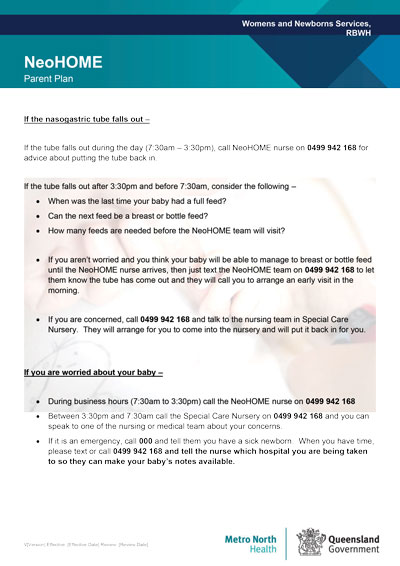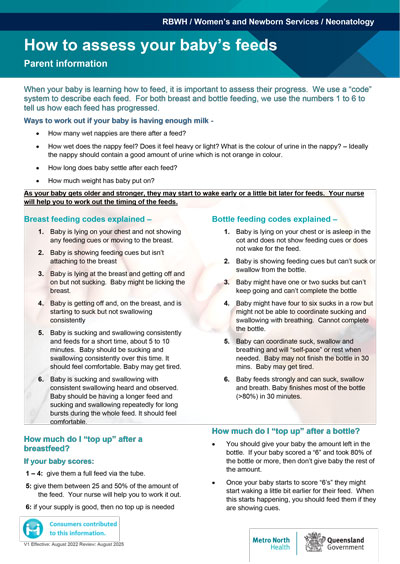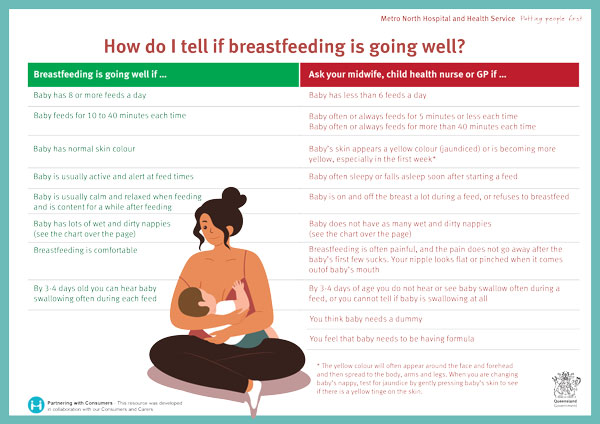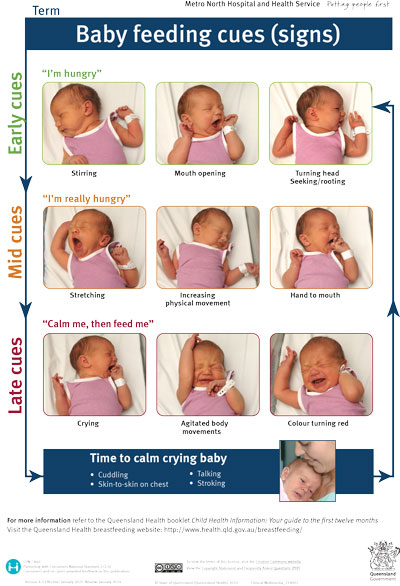Feeding
Whether your baby is breast feeding, bottle feeding or doing a little bit of both, all babies will show “cues” to tell you that they are ready for a feed. Getting to know these cues is the first step to feeding your baby.
Feeding cues
Cues – These are the small signs that a baby shows to say they are ready for a feed. It is best not to wait until your baby is crying, to start to feed. Here are two posters showing you in pictures, what a baby’s “cues” might look like –
Feeding a pre-term baby
Feeding a pre-term baby is a time of learning for both you and your baby. It is important to remember the following points –
- Your baby will start to show readiness to suck from around 33 – 34 weeks though sometimes it can be earlier or later.
- Doing skin to skin will help your baby to tell you that they are ready to try a suck feed.
- When your baby is ready to start feeding, you might find that progress can be slow, especially if your baby was born very early or has been very sick.
- Feeding is a complicated skill, and premature babies get tired very quickly.
- During this learning time, your baby might take small amounts from the breast or bottle, with the rest fed by tube.
- Over time, your baby will be able to take more of their feeds directly from the breast or bottle and less from the tube until eventually, they are taking all their feeds without needing to use the tube at all.
- This can take anywhere from a few days to a few weeks to achieve.

Feeding the late preterm and early term baby
This leaflet explains the differences between feeding a term baby and a late preterm baby
Late preterm babies are those babies born between 34 weeks gestation and 37 completed weeks gestation. Babies born between 37 weeks up to 39 weeks gestation, are considered early term infants and they can behave in similar ways to late preterm babies and face the same challenges.
Working out how well your baby fed
When you baby was in the neonatal unit, your nursing team spoke to you about your baby’s feeding “score”. They may have watched you feed your baby and they may have asked you things like –
- How well did your baby suck?
- How long did they feed for?
- Do your breasts feel softer?
- How much of the bottle did your baby take?

How to assess your baby’s feeds
All those questions help us to work out how effectively your baby has fed. The following link explains how to “score” your baby’s feeding effort. This helps us to monitor their feeding progress together and work out how much milk to give via the tube.
When your baby is learning how to feed, it is important to assess their progress. We use a “code” system to describe each feed. For both breast and bottle feeding, we use the numbers 1 to 6 to tell us how each feed has progressed.

Nasogastric tube feeding
If your baby is having naso-gastric feeds at home, the following information will help you when giving the tube feed
Tube feeding is a way to feed your baby with milk (breast milk, pasteurised donor human milk or formula) while they learn how to feed from the breast or bottle or while they recover from illness. The tube is measured to make sure it is the correct length for your baby and is then inserted into the nose and passed down the food pipe (or oesophagus) and into the stomach. The tube is then taped to your baby’s face to make sure it stays in the right place. The milk is then given to the baby via the tube.
The following video is a great introduction to breastfeeding
New Breastfeeding Basics from Australian Breastfeeding Assn on Vimeo.

How do I tell if breastfeeding is going well?
Some parents worry about how well their baby might be feeding, especially as your baby takes less feeds from the tube and more from the breast. If you need a reminder, have a look at this poster
- Baby has 8 or more feeds a day
- Baby feeds for 10 to 40 minutes each time
- Baby has normal skin colour
Some parents will choose to bottle feed their baby. Bottle feeding a preterm baby is similar to breastfeeding a preterm baby in that your baby will take time to learn how to feed and will need support with tube feeds until they are able to finish their bottle. It is important that you watch your baby during the feed and respond to their cues. Some babies will show you that they have finished their bottle feed by doing the following –
- Using their hands to push the bottle away
- Not opening their mouth to take the bottle
- Looking startled
- Coughing or gagging
Important note
If you plan on breastfeeding your baby, adding bottle feeds when your baby is learning to feed, will not help your baby get home faster or help with having the tube taken out earlier. Your baby still needs to learn how to feed and will do that in their own time.
Other useful feeding resources
- Safe bottle preparation
- Maternal and infant nutrition
- Australian Breastfeeding Association website and Helpline: 1800 mum 2 mum 1800 686 268
Contact us
Location: Level 5, Ned Hanlon Building
Phone: (07) 3646 8918
Email: Neoadmin-Nursing-Support
Visiting hours: 24/7 (Quiet time 1.30pm-3.30pm)
Need help outside hours?
Intensive Care Nursery
Phone: (07) 3646 7946
Special Care Nursery
Phone: (07) 3646 7834


